Estonia's property market slowing sharply
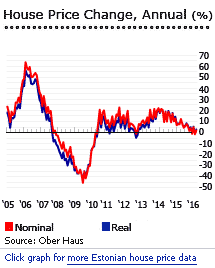 After experiencing strong property price rises in the past three years, Estonia’s property boom seems to have reached its end, with house price rises decelerating sharply.
After experiencing strong property price rises in the past three years, Estonia’s property boom seems to have reached its end, with house price rises decelerating sharply.
During the year to April 2016, the average price of apartments in Tallinn, Estonia’s capital, increased 1.92% (2.75% inflation-adjusted) to €1,590 per square meter (sq. m), a sharp slowdown from an annual rise of 7.44% in the same period last year, according to Ober Haus Real Estate Advisors. During the latest quarter, apartment prices in Tallinn rose by 2.85% (1.46% inflation-adjusted).
This is in line with figures released by Statistics Estonia, which shows that the average purchase price of dwellings in the whole country rose by a meager 0.81% (1.22% inflation-adjusted) in the first quarter of 2016 from a year earlier, to €1,041 per sq. m. This was far from the y-o-y rise of 11.1% (12.1% inflation-adjusted) in Q1 2015 and the lowest annual price increase since Q2 2010.
However, movements of house prices in each of the country’s major cities during the year to end-Q1 2016 vary considerably:
- In Tallinn, Estonia’s capital, the average price of dwellings purchased increased by just 0.73% to €1,555 per sq. m., a sharp slowdown from a y-o-y rise of 8.61% a year ago.
- In Tartu City, the second largest city and the intellectual capital of Estonia, the average price of dwellings purchased rose by a meager 1.04% to €1,218 per sq. m., from an annual rise of 5.61% a year earlier.
- In Parnu City, the country’s summer capital, located in the southwestern, the average price of dwellings purchased rose by 12.06% to €935 per sq. m.
- In Estonia excluding Tallinn, the average purchase price of dwellings dropped 2.66% to €615 per sq. m.
After Estonia’s amazing 36% annual house price rises from 2004 to 2006, prices of dwellings started to fall in 2007, partly due to the global financial meltdown.
- In 2007, the average price of dwellings dropped by 1.5% (-9.7% inflation-adjusted)
- In 2008, the average price of dwellings plunged by 18.3% (-24.5% inflation-adjusted)
- In 2009, house prices plummeted by 30.5% (-29.1% inflation-adjusted)
After these 3 horrendous years, a house price recovery began in the second half of 2010, with the average price of dwellings rising modestly by 4.1% (-1% inflation-adjusted). In 2011, nationwide house prices soared by 12.3% (7.9% inflation-adjusted). In 2013, house prices surged 14.5% (12.9% inflation-adjusted), after rising by 5.4% (1.6% inflation-adjusted) in 2012. Property prices continued to rise, with house prices rising by 8.46% (8.95% inflation-adjusted) in 2014 and 8.07% (8.68% inflation-adjusted) in 2015.
Estonia’s housing market is expected to slow further this year, amidst modest economic growth, according to local property experts.
Estonia’s economy grew by a meager 1.1% last year, after real GDP growth rates of 2.1% in 2014, 1.6% in 2013, 4.7% in 2012, and 8.3% in 2011, mainly due to sharp slowdown in the electronics sector and shale oil sector, and a decline in demand from neighboring Russia. Estonia’s economy is projected to expand by a modest 2.2% this year and by another 2.8% in 2017, according to the International Monetary Fund (IMF).
The great boom of 2000-2007
Estonia’s housing market was in continuous boom from 2000 to 2007. This was due to the following factors:
- low interest rates
- low inflation
- strong economic growth
- rapid wage increases
- huge foreign demand for property, especially from other Europeans
Demand for properties in Tallinn reached an all-time high in 2006, with foreigners attracted by the city’s potential. Tallinn accounted for more than half of all real estate transactions in Estonia.
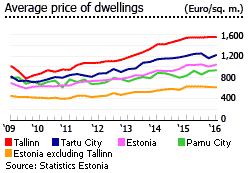
House prices in Estonia rose by double-digit levels from 2000 to 2007. In Tallinn, the average price of 2 room flats rose by an average of 27% annually from 2001 to 2005. House price growth accelerated in 2006, with prices rising by more than 50% y-o-y.
The average price of 2-room flats in Tallinn rose by 448.7% from 2000 to 2007, in Tartu prices rose 431.5% and in Parnu 440%. Prices of three-room flats were equally impressive, rising 412% in Tallinn, 481% in Tartu, and 471.5% in Parnu.
Meanwhile owner-occupancy rates rose strongly, up from 85% in 2002, to 96% in 2004. The rental market shrank from 12% of households (with 9% privately renting and 3% in social rents) in 2002, to just 4% in 2004.
The house price falls in Estonia in 2008 were among the biggest in the world, rivaled only by Latvia. These falls were in sharp contrast to enormous annual price increases in the past, peaking at an annual price increase of 77.5% during the year to end-Q1 2006.
However house prices have seen robust annual increases since the housing market bounced back in 2010.
Land prices also falling
In 2015, land prices in Tallinn fell by 6.2% from a year earlier, according to Ober Haus.
By location:
- In Tallinn’s city center, land prices for residential development ranged from €75 to €130 per sq. m. in 2015.
- In Tallinn’s residential districts, land prices for residential development were around €40 to €90 per sq. m. in 2015.
- In the suburbs of Tallinn, land prices for private homes ranged from €20 to €40 per sq. m. in 2015.
Property demand slowing
In 2015, the number of purchase-sale contracts stood at 46,430 units, up by 3.3% from a year earlier and the highest level since 2007, according to Statistics Estonia. Likewise, the value of contracts also surged by 18.7% to €2.76 billion over the same period.
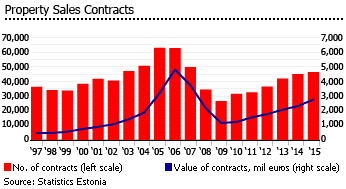
In the first quarter of 2016, there were about 10,403 sales contracts registered, only 1.3% higher as compared to the same period last year. On the other hand, the value of contracts dropped 3.4% y-o-y to €573.65 million in Q1 2016.
Construction activity continues to rise
After the break-up of the Soviet Union in 1991, housing construction in Estonia dramatically decelerated.
From 1996 to 2001 less than 1,000 dwellings were added to the dwelling stock annually - not enough to meet demand. Most apartments were sold before completion.
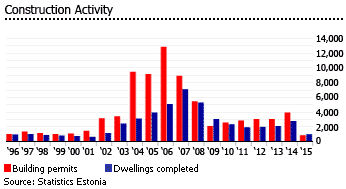
In 2001, housing construction started accelerating. Developers mainly built suburban homes and luxury apartments for middle to upper class Estonians seeking to upgrade from their Soviet-era block buildings. From 2001 to 2007, housing completions averaged 3,800 units every year.
However, construction activity declined sharply in 2008, due to the global crisis. Dwelling completions plunged 25% y-o-y to 5,300 units in 2009. From 2010 to 2013, construction activity remained depressed, with dwelling completions averaged just over 2,000 per year. Residential construction bounced back starting 2014, with dwelling completions rising by 32.5% y-o-y to about 2,800 units. In 2015, dwelling completions surged 44% to 3,969 units from a year earlier.
In the first quarter of 2016, dwelling completions increased 1.7% from the same period last year, to 990 units. On the other hand, building permits soared 60.2% y-o-y to 1,347 units over the same period.
Mortgage market expanding
The house price boom was supported by a massive expansion of the mortgage market, growing by an average of 62% yearly from 2002 to 2006.

Outstanding housing loans grew from 4.4% of GDP in 2000, to 43.2% of GDP in 2009 (from €274.2 million in 2000 to €6.1 billion in 2009), based on figures from Bank of Estonia.
The mortgage market boom was pushed by:
- the favourable macroeconomic environment
- financial market reforms
- the entry of foreign banks and lower interest rates
At the peak of the boom, banks were willing to provide loans with a maximum lending period of 30 years, and a loan-to-value ratio of 100%.
However, from 2009 to 2012, the mortgage market saw a decline, with housing loans falling by an average of 1.5% annually. Then in 2014, housing loans outstanding rose by 2.85% from a year earlier, after a miniscule growth of 0.9% in 2013.
In 2015, the total value of outstanding housing loans rose by 4.2% to €6.27 billion from a year earlier, based on figures from the Bank of Estonia. Likewise, the turnover of housing loans granted to households surged 18.6% y-o-y in 2015, to €89.2 million.
The size of the mortgage market was equivalent to 30.6% of GDP in 2015.
Change over to the euro
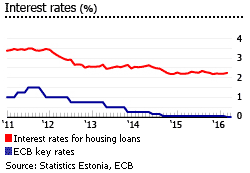
One of the factors that contributed to mortgage and house price boom was the pegging of the Estonian kroon to the deutschemark in 1992 and eventually to the euro in 2001. In June 2004, Estonia entered ERM 2 in preparation for the eventual adoption of the euro. Although the kroon is allowed to fluctuate within a 15% band, Estonia preferred a peg of EEK 15.6466 per euro. This led to lower inflation and lower interest rates.
Mortgage interest rates fell from over 10% during the late-1990s, to below 4% between 2004 and 2006. Estonia managed to bring down inflation from 89% in 1992 to the single-digit level of 8.2% in 1998. Between 2002 and 2006, inflation was below 4.5% (an average of 3.3%).
As a consequence of the peg to the euro, interest rates in Estonia followed key rates set by the European Central Bank (ECB). Hence when the ECB began to raise key rates in mid-2005, mortgage rates also increased in Estonia. ECB base rates were gradually raised in 25 basis point steps, from 2% in October 2005 to 4% in May 2007, and again to 4.25% in July 2008.
By November 2008, the interest rates for kroon denominated housing loans rose to 7.37%. For euro denominated loans, housing loan rates rose to 6.27% in October 2008. These interest rate hikes proved too much for Estonia’s housing market to bear and contributed to massive house price falls.
In an effort to ease the credit crunch and economic downturn, the ECB reduced key interest rates. It adjusted the key rate successively from 4.25% in September 2008 to 1% in May 2009, where the rate has remained until now. With this, the euro housing loan rate fell to 3.43% in February 2010.
In 2010, the country successfully fulfilled all the Maastricht criteria, which are required to join the euro zone. Effective 1 January 2011, the euro became the official currency of Estonia. The changeover to the euro was expected to support economic stability, boost business and investor confidence, and the living standard of Estonian people, among others.
Interest rates in Estonia continued to follow key rates set by the ECB. In September 2014, the ECB slashed the key rate by 10 basis points to a record low of 0.05%, the second rate cut for the year. The key rate remained unchanged until March 2016 when the ECB decided to cut it to zero to revive the economy and fend off deflation.
Despite this, the average interest rate for housing loans increased slightly to 2.24% in March 2016 from 2.2% a year earlier, according to Statistics Estonia.
Moderate rental yields
Gross rental yields from apartments in Tallinn are moderate, ranging from 5.3% to 6.3%, according to Global Property Guide research conducted in July 2015. This was supported by Ober Haus, which showed that gross rental yields of apartments in Tallinn in 2015 stood from 5% to 6%, depending on location.
Smaller apartments tend to earn higher rental returns. A 40 sq. m. apartment has moderate to good rental yields at 6.3%, whereas a 120 sq. m. apartment earns somewhat poorer rental yields at 5.3%.
Renting costs, on average, EUR384 for a 40 sq. m. apartment per month, whereas for a 120 sq. m. apartment, monthly rents are around EUR1,145, according to Global Property Guide. By end-2015, the asking price for rental apartments in the city center was €10 per sq. m. and €8 to €9 per sq. m. in the suburbs of Tallinn, according to Ober Haus.
Modest economic growth, falling unemployment
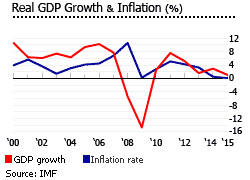
From 2000 to 2006, Estonia’s economy expanded by an average of 8% annually, including resounding 10.4% GDP growth in 2006, and 9.5% growth in 2005. In 2007, GDP growth was 7.9%, one of the highest growth rates in the EU. Unemployment fell from 13% in 2000, to just 4.6% in 2007.
The economy contracted by 5.4% in 2008, and by a staggering 14.7% in 2009. As the country fell deeper into recession, the government cut spending by about 7.8% in 2009. It kept its income tax rates low, but hiked VAT by 2% to 20% in July 2009. By 2010 Estonian unemployment had risen to 16.7%.
The economy recovered in 2010 with GDP growth of 2.5% and a fiscal budget surplus. In January 2011, Estonia was the first country since the financial crisis to join the Eurozone.
Estonia had astounding growth of 7.6% in 2011, with strong exports. Unemployment fell to 12.3%. Then in 2012, the economy expanded by a robust 5.2%, bolstered by construction and export growth.
However, the economy slowed sharply in 2013, with real GDP growth rate of just 1.6%, mainly due to the high reference base of government sector investments, weakness of exports and rising inflation. Estonia’s economy grew by 2.9% in 2014 and by just 1.1% in 2015, mainly due to sharp slowdown in the electronics sector and shale oil sector, and a decline in demand from neighboring Russia, based on IMF figures.
Estonia’s economy is projected to expand by a modest 2.2% this year and by another 2.8% in 2017, according to the IMF. On the other hand, the European Commission gives more conservative projections, expecting growth rates of 1.9% in 2016 and 2.4% in 2017.
Unemployment was down to 6.8% in 2015, from 7% in 2014 and 8.6% in 2015. During the first quarter of 2016, nationwide unemployment rate stood at 6.5%, slightly up from 6.4% in the previous quarter and 6.3% in a year earlier, according to Statistics Estonia. The jobless rate is expected at around 6.5% this year.
In 2015, the average monthly gross wages and salaries rose by 6% to €1,065 from a year earlier, according to Statistics Estonia. In Q1 2016, the average monthly gross wages and salaries increased 8.1% y-o-y to €1,091 while the average hourly gross wages and salaries rose by 7.7% y-o-y to €6.86. Yet inflation remained low at 0.07% in 2015, from 0.5% in 2014, 3.2% in 2013, 4.2% in 2012, and 5.1% in 2011, according to the IMF.
In April 2016, consumer prices fell by 0.1% from the previous month and by 0.8% from the same period last year, according to the Bank of Estonia.
In 2015, Estonia registered a government surplus of about €84.1 million or 0.4% of GDP, from a surplus of €121 million in 2014, and deficits of €40 million in 2013 and €39 million in 2012, according to Statistics Estonia.
Estonia’s national debt declined to €1.99 billion in 2015, from €2.07 billion in a year ago, according to Statistics Estonia. The country had the smallest national debt level across the European Union, at just 9.7% of GDP last year.